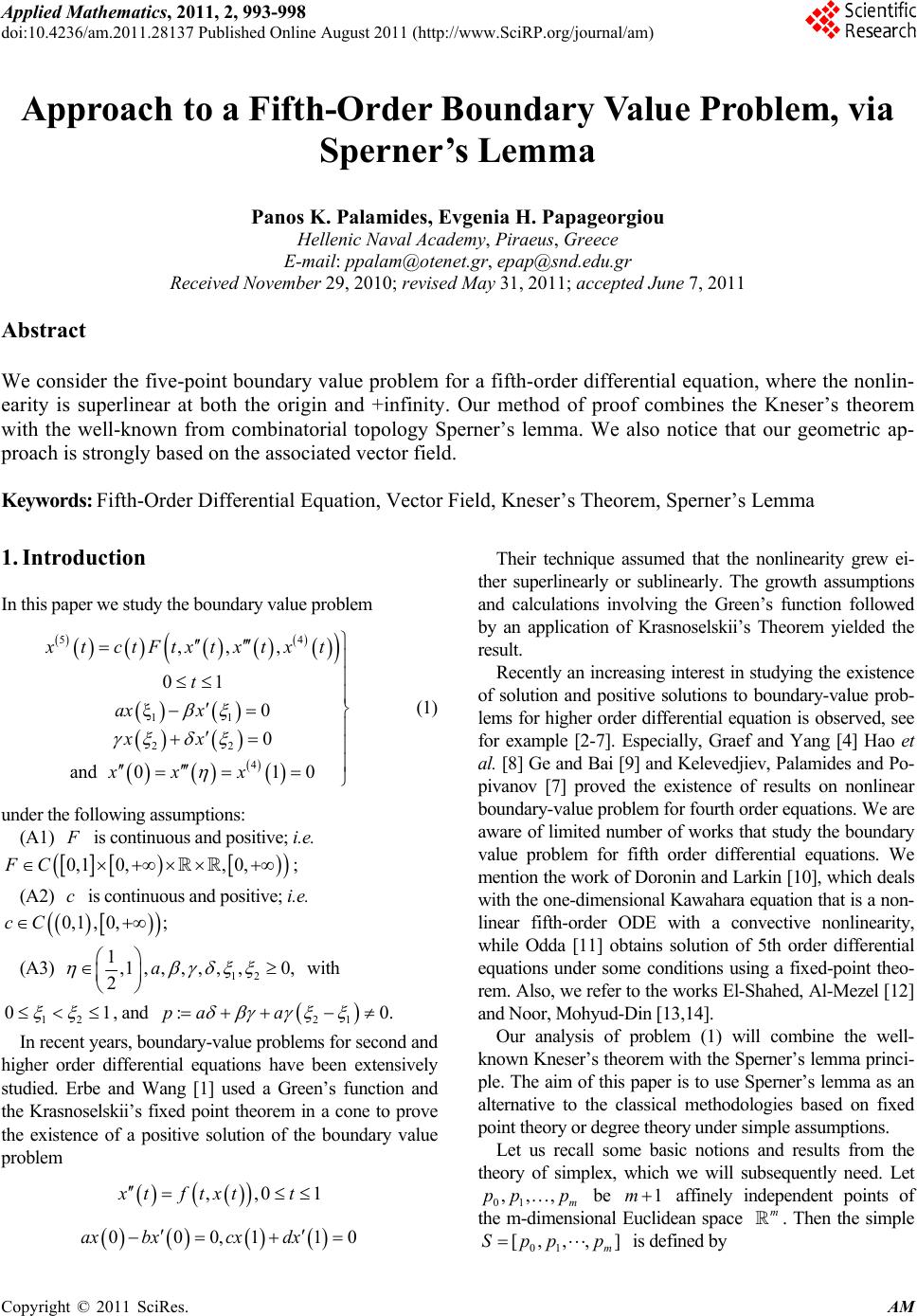 Applied Mathematics, 2011, 2, 993-998 doi:10.4236/am.2011.28137 Published Online August 2011 (http://www.SciRP.org/journal/am) Copyright © 2011 SciRes. AM Approach to a Fifth-Order Boundary Value Problem, via Sperner’s Lemma Panos K. Palamides, Evgenia H. Papageorgiou Helleni c Naval Academy, Piraeus, Greece E-mail: ppalam@otenet.gr, epap@snd.edu.gr Received November 29, 2010; revised May 31, 2011; accepted June 7, 2011 Abstract We consider the five-point boundary value problem for a fifth-order differential equation, where the nonlin- earity is superlinear at both the origin and +infinity. Our method of proof combines the Kneser’s theorem with the well-known from combinatorial topology Sperner’s lemma. We also notice that our geometric ap- proach is strongly based on the associated vector field. Keywords: Fifth-Order Differential Equation, Vector Field, Kneser’s Theorem, Sperner’s Lemma 1. Introduction In this paper we study the boundary value problem 54 11 22 4 ,, , 01 ξ0 0 and01 0 tctFtxtxtx t t ax x xx xx x (1) under the following assumptions: (A1) is continuous and positive; i.e. 0,10,, 0,FC ; (A2) is continuous and positive; i.e. c 0,1 ,0,;cC (A3) 12 1,1 ,,,,,,0, 2a with 12 01 , and 21 :pa a 0. 1 In recent years, boundary-value problems for second and higher order differential equations have been extensively studied. Erbe and Wang [1] used a Green’s function and the Krasnoselskii’s fixed point theorem in a cone to prove the existence of a positive solution of the boundary value problem ,,0 tftxt t 0 000,11axbxcx dx Their technique assumed that the nonlinearity grew ei- ther superlinearly or sublinearly. The growth assumptions and calculations involving the Green’s function followed by an application of Krasnoselskii’s Theorem yielded the result. Recently an increasing interest in studying the existence of solution and positive solutions to boundary-value prob- lems for higher order differential equation is observed, see for example [2-7]. Especially, Graef and Yang [4] Hao et al. [8] Ge and Bai [9] and Kelevedjiev, Palamides and Po- pivanov [7] proved the existence of results on nonlinear boundary-value problem for fourth order equations. We are aware of limited number of works that study the boundary value problem for fifth order differential equations. We mention the work of Doronin and Larkin [10], which deals with the one-dimensional Kawahara equation that is a non- linear fifth-order ODE with a convective nonlinearity, while Odda [11] obtains solution of 5th order differential equations under some conditions using a fixed-point theo- rem. Also, we refer to the works El-Shahed, Al-Mezel [12] and Noor, Mohyud-Din [13,14]. Our analysis of problem (1) will combine the well- known Kneser’s theorem with the Sperner’s lemma princi- ple. The aim of this paper is to use Sperner’s lemma as an alternative to the classical methodologies based on fixed point theory or degree theory under simple assumptions. Let us recall some basic notions and results from the theory of simplex, which we will subsequently need. Let 01 ,,, m pp p be 1m affinely independent points of the m-dimensional Euclidean space . Then the simple m 01 [,,Spp, m p] is defined by 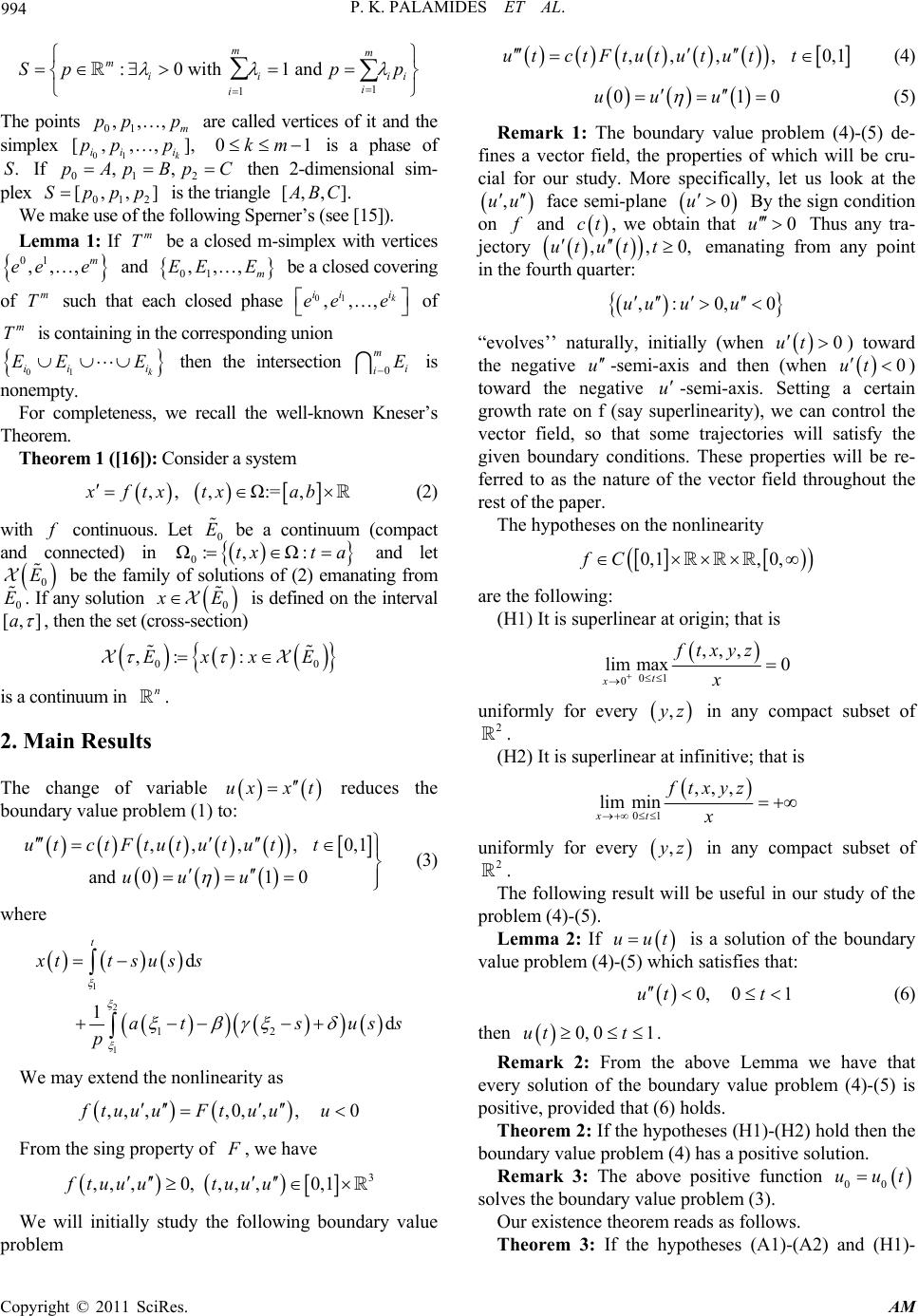 P. K. PALAMIDES ET AL. 994 ii ,1 1 1 :0 with1 and mm mii i i Spp p The points are called vertices of it and the simplex 01 ,,, m pp p 01 [,,, k ii i pp p]0km C [, is a phase of If 2 then 2-dimensional sim- plex is the triangle .S01 ,,pApB [,, ]Sp pp p 012 , ]. BC We make use of the following Sperner’s (see [15]). Lemma 1: If be a closed m-simplex with vertices and be a closed covering of such that each closed phase of is containing in the corresponding union then the intersection is nonempty. m T k E 01 ,, , m ee e m T m T 01 ii EE 01 ,,, m EE E i 01 ,,, k ii i ee e 0 m i iE For completeness, we recall the well-known Kneser’s Theorem. Theorem 1 ([16]): Consider a system ,, ,Ω:= ,xf txtxab (2) with continuous. Let be a continuum (compact and connected) in f0 E 0 Ω:, Ω:txt a and let be the family of solutions of (2) emanating from . If any solution E 0 E 0 0 E is defined on the interval [,a] , then the set (cross-section) 00 ,: :ExxE is a continuum in . n 2. Main Results The change of variable uxx t reduces the boundary value problem (1) to: ,, ,,0,1 and 010 ut ctFtutututt uu u (3) where 1 2 1 12 d 1d t xtt suss ats us p s We may extend the nonlinearity as ,, ,,0, ,,0ftuuuFtuuu From the sing property of , we have 3 ,, ,0,,, ,0,1ftuu utuu u We will initially study the following boundary value problem ,, ,,0,1ut ctFtutututt (4) 0uu u 10 (5) Remark 1: The boundary value problem (4)-(5) de- fines a vector field, the properties of which will be cru- cial for our study. More specifically, let us look at the ,uu face semi-plane 0u By the sign condition on and f ct, we obtain that Thus any tra- jectory 0u t t , utu ,0, emanating from any point in the fourth quarter: ,: 0,0uu uu “evolves’’ naturally, initially (when 0ut ) toward the negative u -semi-axis and then (when 0ut ) toward the negative u -semi-axis. Setting a certain growth rate on f (say superlinearity), we can control the vector field, so that some trajectories will satisfy the given boundary conditions. These properties will be re- ferred to as the nature of the vector field throughout the rest of the paper. The hypotheses on the nonlinearity 0,1, 0,fC are the following: (H1) It is superlinear at origin; that is 01 0 ,,, lim max0 t x ftxyz x uniformly for every , z in any compact subset of . 2 (H2) It is superlinear at infinitive; that is 01 ,,, lim min xt ftxyz x uniformly for every , z in any compact subset of . 2 The following result will be useful in our study of the problem (4)-(5). Lemma 2: If uut is a solution of the boundary value problem (4)-(5) which satisfies that: 0, 01ut t (6) then 0, 01ut t. Remark 2: From the above Lemma we have that every solution of the boundary value problem (4)-(5) is positive, provided that (6) holds. Theorem 2: If the hypotheses (H1)-(H2) hold then the boundary value problem (4) has a positive solution. Remark 3: The above positive function 00 uut solves the boundary value problem (3). Our existence theorem reads as follows. Theorem 3: If the hypotheses (A1)-(A2) and (H1)- Copyright © 2011 SciRes. AM 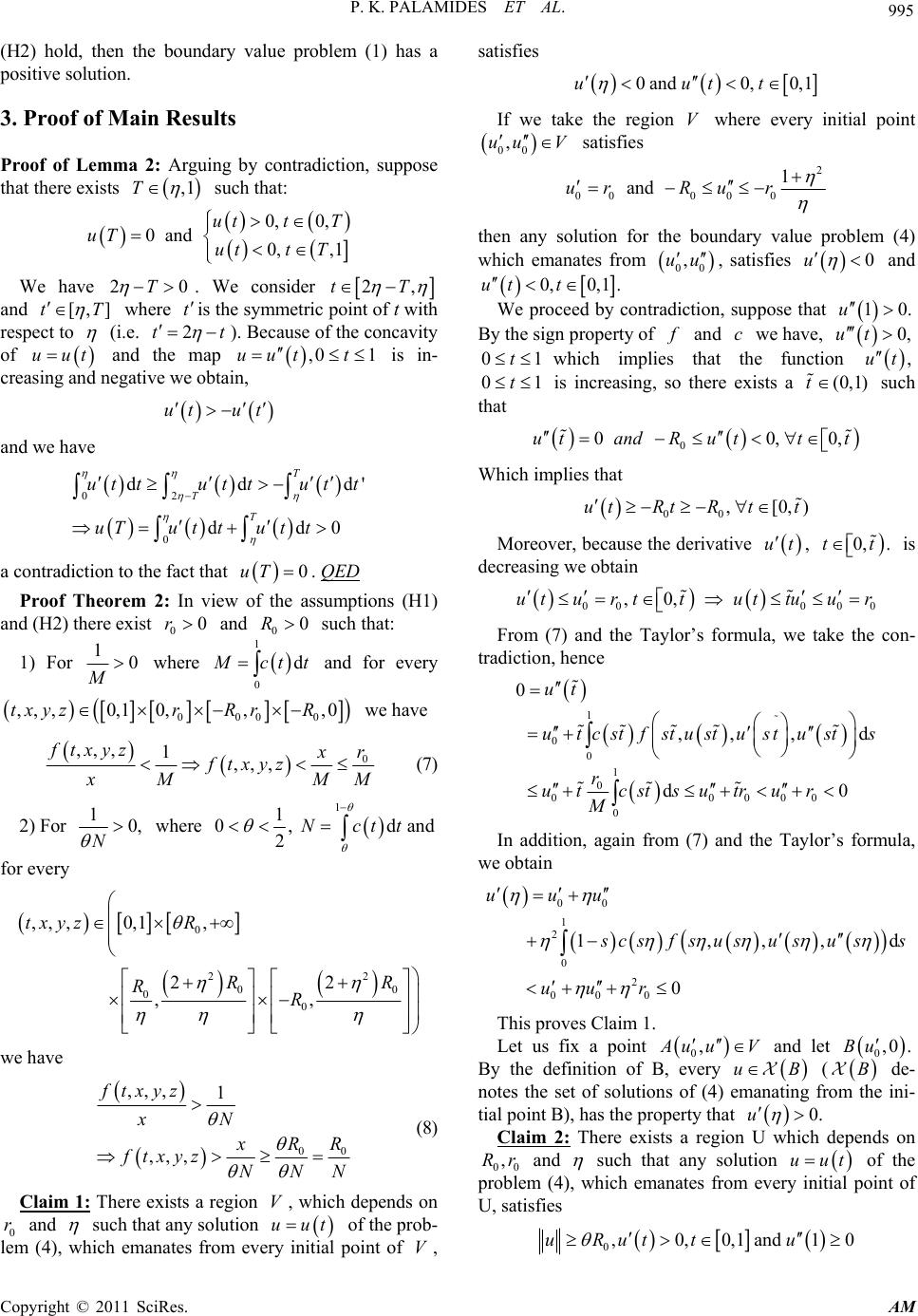 P. K. PALAMIDES ET AL. 995 (H2) hold, then the boundary value problem (1) has a positive solution. 3. Proof of Main Results Proof of Lemma 2: Arguing by contradiction, suppose that there exists ,1T such that: 0, 0, 0and 0, ,1 utt T uT utt T 0 We have 2T . We consider 2,tT and [,t]T where is the symmetric point of t with respect to t (i.e. 2tt ). Because of the concavity of and the map is in- creasing and negative we obtain, uut ,0uut 1t ut ut d' 0 and we have 02 0 dd dd T T T ut tut tutt uTuttu tt a contradiction to the fact that . 0uT QED Proof Theorem 2: In view of the assumptions (H1) and (H2) there exist and such that: 00r00R 1) For 10 where 0 d 1 ct t and for every 0 ,,,0,10,,0txyz R 000 ,rRr we have 0 ,,,1,,, ftxyz r x ftxyz MM M (7) 2) For 10, N where 1 0, 2 1 dNct tand for every 0 22 00 0 0 ,,,0,1, 22 ,, txyz R RR RR we have 00 ,,,1 ,,, ftxyz xN RR x ftxyz NNN (8) Claim 1: There exists a region , which depends on 0 and V r such that any solution of the prob- lem (4), which emanates from every initial point of , satisfies uutV 0 and0,0,1uutt If we take the region V where every initial point 00 ,uuV satisfies 2 00000 1 andurRu r then any solution for the boundary value problem (4) which emanates from 00 ,uu , satisfies 0u and 0,0,1 .ut t We proceed by contradiction, suppose that u 10. By the sign property of and we have, c 0,ut 0t ,ut 1 which implies that the function 0t1 is increasing, so there exists a such that (0t ,1) 0 00,utand R uttt 0, Which implies that 00 ,[0,utRtR tt ) Moreover, because the derivative , is decreasing we obtain ut 0, .tt 000 0 ,0,uturt tuttuur 0 From (7) and the Taylor’s formula, we take the con- tradiction, hence 1 0 0 1 0 0000 0 0 ,, , d0 ut utcstfstustustust s r ut cstsutrur M 0 d In addition, again from (7) and the Taylor’s formula, we obtain 00 1 2 0 2 00 0 1,,, 0 uuu d csfsus us uss uur This proves Claim 1. Let us fix a point 0, uu V and let 0,0.Bu By the definition of B, every ( uB B de- notes the set of solutions of (4) emanating from the ini- tial point B), has the property that 0. u Claim 2: There exists a region U which depends on 00 and ,Rr such that any solution uut of the problem (4), which emanates from every initial point of U, satisfies 0,0,0,1and1uRut tu 0 Copyright © 2011 SciRes. AM 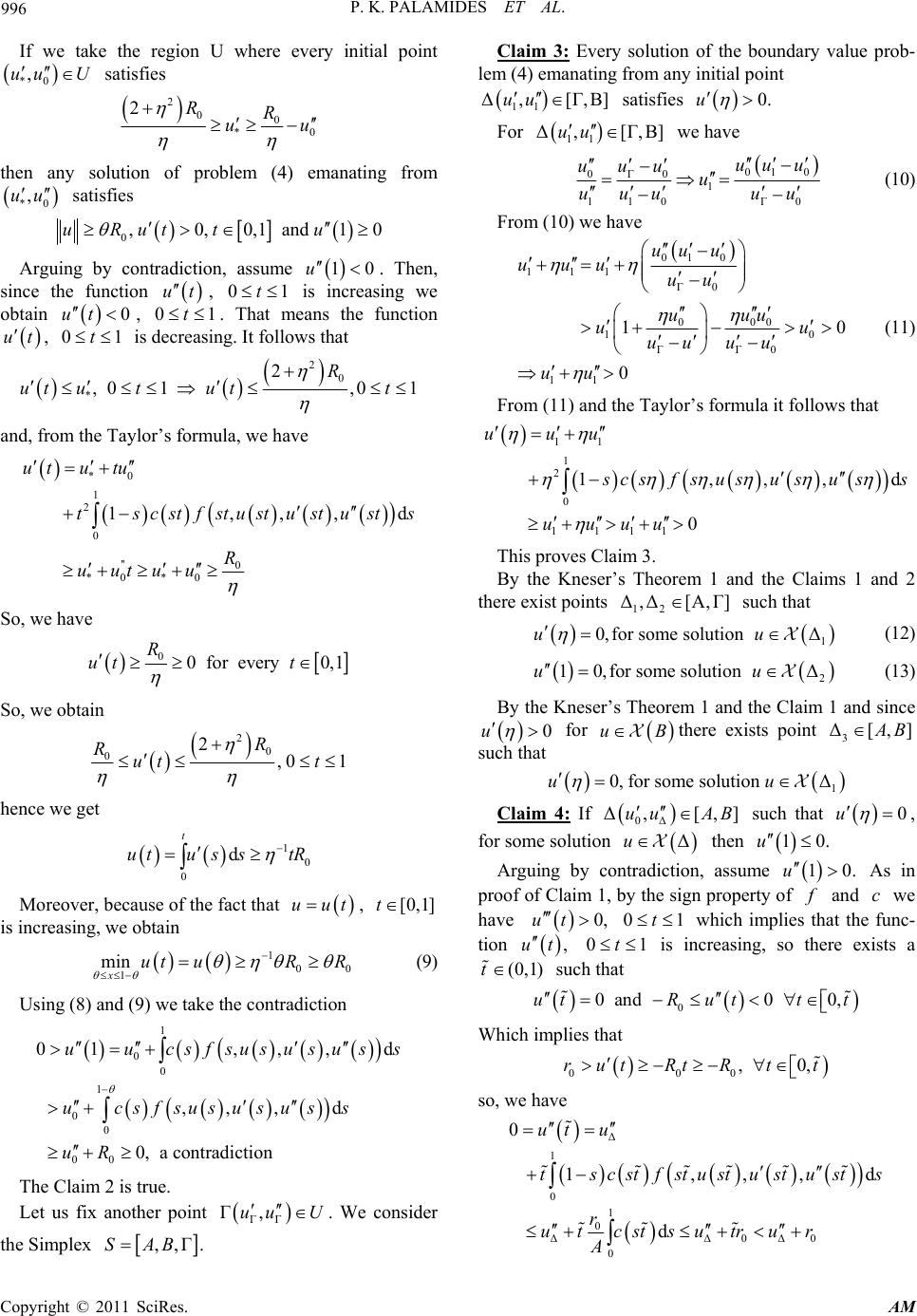 996 P. K. PALAMIDES ET AL. If we take the region U where every initial point satisfies *0 ,uu U 2 00 *0 2RR uu then any solution of problem (4) emanating from satisfies *0 ,uu 0,0,0,1and1uRuttu 0 Arguing by contradiction, assume . Then, since the function , 10u 1 ut 0t 1 is increasing we obtain , . That means the function , is decreasing. It follows that 0ut 01t 0t ut 2 0 * 2 ,0 1,0 1 R ut ututt and, from the Taylor’s formula, we have *0 1 2 0 '' 0 *0 *0 1,,, utu tu tscst f stustu stusts R uutuu d So, we have 00for every 0,1 R ut t So, we obtain 2 0 02,0 1 R Rut t hence we get 1 0 0 d t utusstR Moreover, because of the fact that , uut[0,1]t is increasing, we obtain 1 0 1 min xut uRR 0 (9) Using (8) and (9) we take the contradiction 1 0 0 1 0 00 0 01 ,,, ,, ,d 0,a contradiction uucsfsususus ucsfsususus s uR ds The Claim 2 is true. Let us fix another point ΓΓ Γ,uu U . We consider the Simplex ,,Γ.SAB Claim 3: Every solution of the boundary value prob- lem (4) emanating from any initial point 11 Δ,[Γ,Β]uu satisfies 0.u For 11 Δ,[Γ,Β]uu we have 010 0Γ0 1 110 Γ0 uu u uuu u uuu uu (10) From (10) we have 010 111 Γ0 000 10 ΓΓ0 11 10 0 uu u uuu uu uuu uu uu uu uu (11) From (11) and the Taylor’s formula it follows that 11 1 2 0 1111 1,,, 0 uuu d csfsus us uss uuuu This proves Claim 3. By the Kneser’s Theorem 1 and the Claims 1 and 2 there exist points 12 Δ,Δ[Α,Γ] such that 1 0,for some solutionΔuu (12) 2 10,for some solutionΔuu (13) By the Kneser’s Theorem 1 and the Claim 1 and since 0u for uBthere exists point 3 Δ[,] B such that 1 0, for some solutionΔuu Claim 4: If 0Δ Δ,[,uu AB ] such that 0u , for some solution Δu then 10u. Arguing by contradiction, assume 10u . As in proof of Claim 1, by the sign property of and c we have 0,ut 0t1 which implies that the func- tion ,ut 0 1t is increasing, so there exists a (0,1)t such that 0 0and0 0,utR uttt Which implies that 000 ,0,rutRtRtt so, we have Δ 1 0 1 0 ΔΔ0Δ0 0 0 1,,, d ut u ts cstfstustustusts r ut cstsutrur A d Copyright © 2011 SciRes. AM 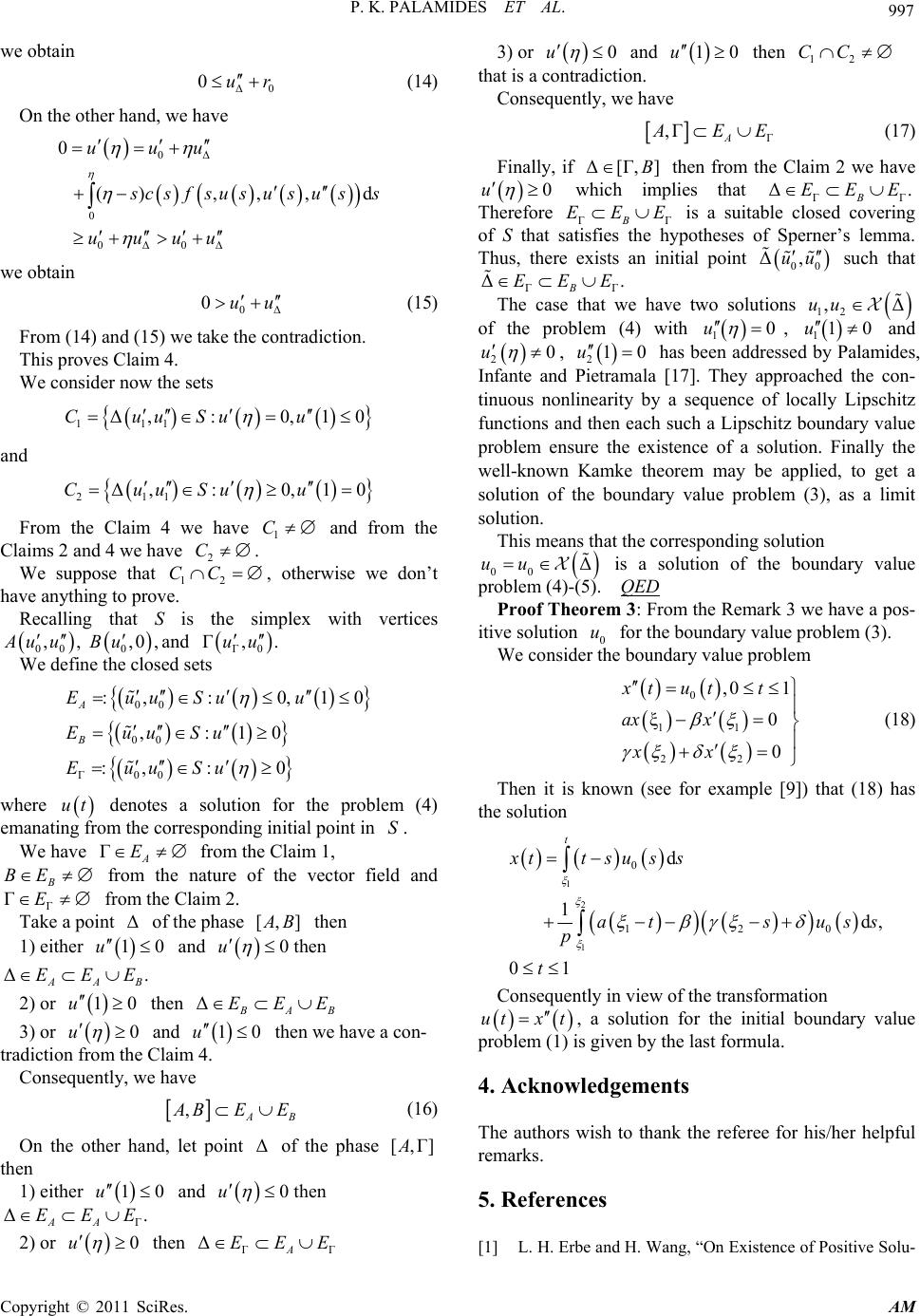 P. K. PALAMIDES ET AL. 997 we obtain Δ0 0ur (14) On the other hand, we have 0Δ 0 0Δ0Δ 0 (),,,d uuu csfsus us uss uuuu we obtain 0Δ 0uu (15) From (14) and (15) we take the contradiction. This proves Claim 4. We consider now the sets 111 Δ,: 0,1CuuSu u 0 and 211 Δ,: 0,1CuuSu u 0 From the Claim 4 we have and from the Claims 2 and 4 we have . 1 C 2 C CC We suppose that 12 , otherwise we don’t have anything to prove. Recalling that S is the simplex with vertices 00 ,, uu 0,0 ,Bu and Γ0 Γ,.uu We define the closed sets 00 0 0 Γ0 0 :, :0,10 ,:10 :, :0 A B uEuSuu EuSu EuSu u u where denotes a solution for the problem (4) emanating from the corresponding initial point in . ut S We have from the Claim 1, from the nature of the vector field and from the Claim 2. ΓA E Δ B BE ΓE Γ Take a point of the phase [,] B then 1) either and 10u 0thenu ΔEE . AAB E 2) or then 10u Δ AB EEE 3) or and 0u 10u then we have a con- tradiction from the Claim 4. Consequently, we have ,AB BEE (16) On the other hand, let point of the phase [, then Δ Γ]A 1) either and 10u 0thenu Γ ΔAA EE .E 2) or then 0u ΓΓ ΔA EEE 3) or 0u and 10u then 12 CC that is a contradiction. Consequently, we have Γ ,ΓA EE (17) Finally, if Δ[Γ,]B then from the Claim 2 we have 0u ΔEE which implies that ΓΓ Therefore ΓΓB is a suitable closed covering of S that satisfies the hypotheses of Sperner’s lemma. Thus, there exists an initial point such that .ΔB EEE 00 ,Δuu EE .E E ΓΓB The case that we have two solutions ,Δuu 12 110u of the problem (4) with , 10u and 20u , 210u has been addressed by Palamides, Infante and Pietramala [17]. They approached the con- tinuous nonlinearity by a sequence of locally Lipschitz functions and then each such a Lipschitz boundary value problem ensure the existence of a solution. Finally the well-known Kamke theorem may be applied, to get a solution of the boundary value problem (3), as a limit solution. This means that the corresponding solution 00 Δuu is a solution of the boundary value problem (4)-(5). QED Proof Theorem 3: From the Remark 3 we have a pos- itive solution for the boundary value problem (3). 0 We consider the boundary value problem u 0 11 22 ,0 1 ξ0 0 xt utt ax x xx (18) Then it is known (see for example [9]) that (18) has the solution 1 2 1 0 120 d 1d, 01 t xtt su ss ats us p t s Consequently in view of the transformation utxt , a solution for the initial boundary value problem (1) is given by the last formula. 4. Acknowledgements The authors wish to thank the referee for his/her helpful remarks. 5. References [1] L. H. Erbe and H. Wang, “On Existence of Positive Solu- Copyright © 2011 SciRes. AM 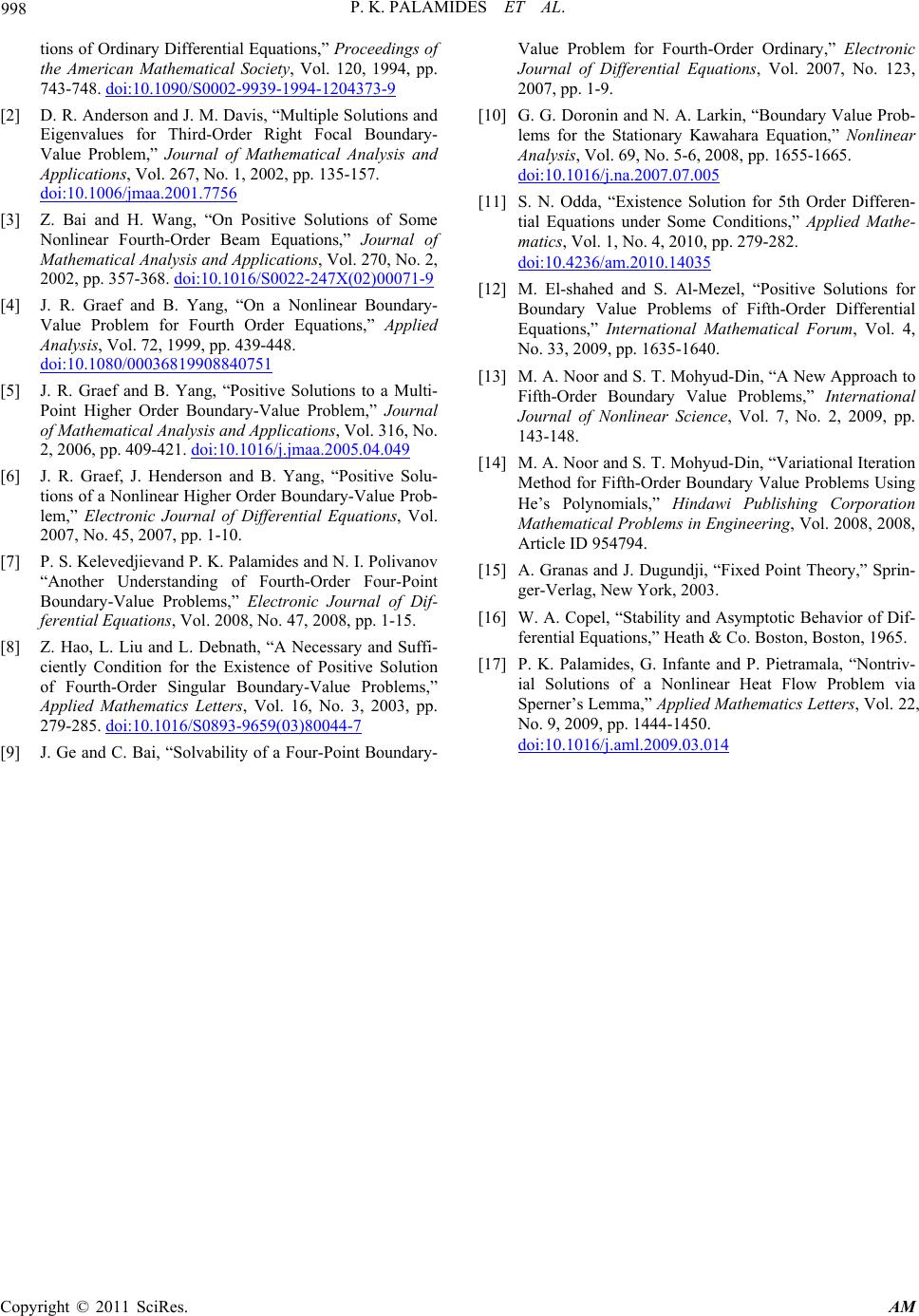 P. K. PALAMIDES ET AL. Copyright © 2011 SciRes. AM 998 tions of Ordinary Differential Equations,” Proceedings of the American Mathematical Society, Vol. 120, 1994, pp. 743-748. doi:10.1090/S0002-9939-1994-1204373-9 [2] D. R. Anderson and J. M. Davis, “Multiple Solutions and Eigenvalues for Third-Order Right Focal Boundary- Value Problem,” Journal of Mathematical Analysis and Applications, Vol. 267, No. 1, 2002, pp. 135-157. doi:10.1006/jmaa.2001.7756 [3] Z. Bai and H. Wang, “On Positive Solutions of Some Nonlinear Fourth-Order Beam Equations,” Journal of Mathematical Analysis and Applications, Vol. 270, No. 2, 2002, pp. 357-368. doi:10.1016/S0022-247X(02)00071-9 [4] J. R. Graef and B. Yang, “On a Nonlinear Boundary- Value Problem for Fourth Order Equations,” Applied Analysis, Vol. 72, 1999, pp. 439-448. doi:10.1080/00036819908840751 [5] J. R. Graef and B. Yang, “Positive Solutions to a Multi- Point Higher Order Boundary-Value Problem,” Journal of Mathematical Analysis and Applications, Vol. 316, No. 2, 2006, pp. 409-421. doi:10.1016/j.jmaa.2005.04.049 [6] J. R. Graef, J. Henderson and B. Yang, “Positive Solu- tions of a Nonlinear Higher Order Boundary-Value Prob- lem,” Electronic Journal of Differential Equations, Vol. 2007, No. 45, 2007, pp. 1-10. [7] P. S. Kelevedjievand P. K. Palamides and N. I. Polivanov “Another Understanding of Fourth-Order Four-Point Boundary-Value Problems,” Electronic Journal of Dif- ferential Equations, Vol. 2008, No. 47, 2008, pp. 1-15. [8] Z. Hao, L. Liu and L. Debnath, “A Necessary and Suffi- ciently Condition for the Existence of Positive Solution of Fourth-Order Singular Boundary-Value Problems,” Applied Mathematics Letters, Vol. 16, No. 3, 2003, pp. 279-285. doi:10.1016/S0893-9659(03)80044-7 [9] J. Ge and C. Bai, “Solvability of a Four-Point Boundary- Value Problem for Fourth-Order Ordinary,” Electronic Journal of Differential Equations, Vol. 2007, No. 123, 2007, pp. 1-9. [10] G. G. Doronin and N. A. Larkin, “Boundary Value Prob- lems for the Stationary Kawahara Equation,” Nonlinear Analysis, Vol. 69, No. 5-6, 2008, pp. 1655-1665. doi:10.1016/j.na.2007.07.005 [11] S. N. Odda, “Existence Solution for 5th Order Differen- tial Equations under Some Conditions,” Applied Mathe- matics, Vol. 1, No. 4, 2010, pp. 279-282. doi:10.4236/am.2010.14035 [12] M. El-shahed and S. Al-Mezel, “Positive Solutions for Boundary Value Problems of Fifth-Order Differential Equations,” International Mathematical Forum, Vol. 4, No. 33, 2009, pp. 1635-1640. [13] M. A. Noor and S. T. Mohyud-Din, “A New Approach to Fifth-Order Boundary Value Problems,” International Journal of Nonlinear Science, Vol. 7, No. 2, 2009, pp. 143-148. [14] M. A. Noor and S. T. Mohyud-Din, “Variational Iteration Method for Fifth-Order Boundary Value Problems Using He’s Polynomials,” Hindawi Publishing Corporation Mathematical Problems in Engineering, Vol. 2008, 2008, Article ID 954794. [15] A. Granas and J. Dugundji, “Fixed Point Theory,” Sprin- ger-Verlag, New York, 2003. [16] W. A. Copel, “Stability and Asymptotic Behavior of Dif- ferential Equations,” Heath & Co. Boston, Boston, 1965. [17] P. K. Palamides, G. Infante and P. Pietramala, “Nontriv- ial Solutions of a Nonlinear Heat Flow Problem via Sperner’s Lemma,” Applied Mathematics Letters, Vol. 22, No. 9, 2009, pp. 1444-1450. doi:10.1016/j.aml.2009.03.014
|